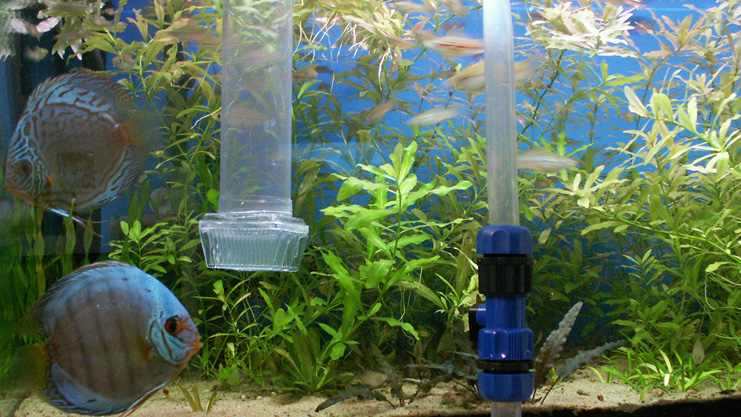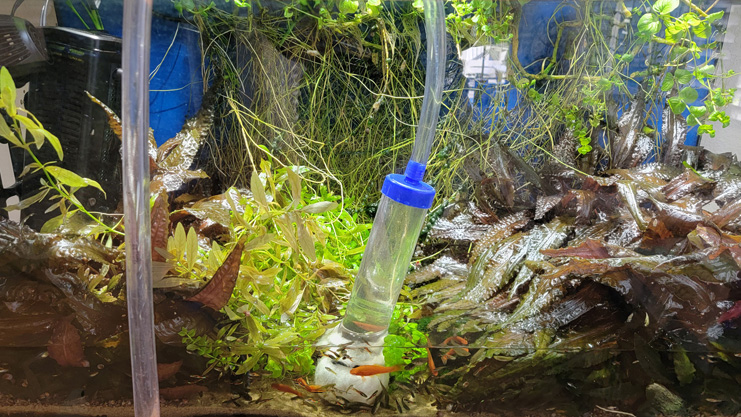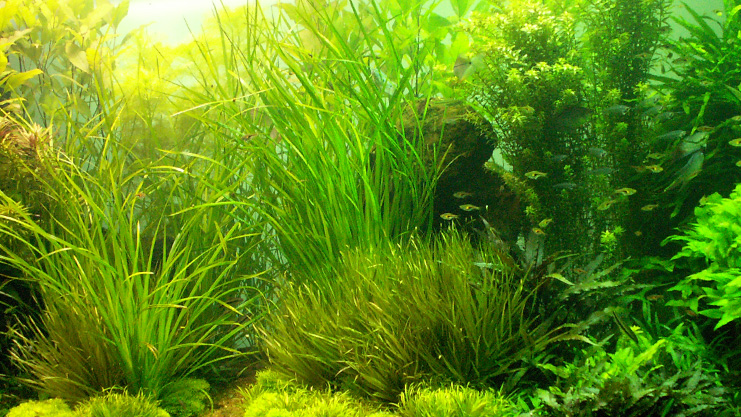The Silent Killer
How to Use a Gravel Vacuum in the Modern Aquarium

By Tony Griffitts
Published - 20060703, , Revised:
Under Gravel (UG) filtration was a prevalent filtration system in the 1970s and 80s. The UG filter necessitated the invention of the gravel vacuum to clean the detritus out of the substrate. The gravel vacuum is a piece of essential equipment for hobbyists still using UG filtration.
The UG filtration system provides mechanical and biological filtration. The hobbyist must vacuum the substrate to prevent channeling and maximize biological filtration.
In a UG filtration system, the gravel vacuum tube is shoved deep into the substrate to the point where it touches the filter plate and is moved to a new spot when the water is clear. The gravel vacuum is the best way to remove trapped detritus from the gravel bed for UG filtered aquariums.
In the modern aquarium (no UG filter), using the gravel vacuum with the same method as a system that uses a UG filter will cause detrimental effects on the system. The damaging effects include:
- Removing beneficial organisms.
- Disrupting the ecological balance of the substrate.
- Ammonia and or nitrite can spike a few days after vacuum.
- Death of your aquatic life a few days after the cleaning.
After a hobbyist incorrectly shoves the gravel vacuum into the sand or gravel in a modern aquarium, the distinct layers of the substrate are jumbled up. The top layer of the substrate will no longer be heavily colonized with aerobic bacteria that need to be in contact with the water column. Since much of your nitrifying bacteria population is no longer in contact with the water column, the nitrogen cycle will be degraded. Ammonia and nitrite can reach deadly toxic levels in three to five days after a heavy gravel vacuum.
When ammonia and nitrite reach toxic levels, you need to do a significant (90% or more) water change to reduce the ammonia and nitrite concentrations to an acceptable level for your fish. It could take weeks for your modern aquarium ecosystem to recover from a deep gravel vacuum, so you will need to test your water for ammonia and nitrite every couple of days and lighten the feeding until the ammonia and nitrite levels return to 0 ppm.

In a modern aquarium, sand has many advantages over gravel in freshwater and marine systems. First, it helps keep the detritus on top of the bed so power filters can pull it out of your aquarium, allowing it to be removed from the system when you clean your filter. It also aids Natural Nitrate Reduction (NNR), allowing only a slow water exchange through the bed. The slow water exchange through the sand bed allows two distinct beneficial ecological layers to develop.
The top layer of the bed, which is in contact with oxygen-rich water (aerobic), is heavily colonized by the nitrifying bacteria from the Nitrosopira and Nitrospira genus. These bacteria are responsible for converting the ammonia and nitrite in the aquarium to the many times less toxic nitrate. Without a sufficient number of these good bacteria in your system, the ammonia and nitrite will shoot up to a toxic level (24 hours of exposure at or above .6 ppm for ammonia, 2 ppm for nitrite), which will kill fish.
The bottom layer has a special kind of bacteria called anaerobic bacteria. Anaerobic bacteria live in environments where there is no oxygen available. In the aquarium, anaerobic bacteria use the oxygen atom from the nitrate molecule, thereby converting the nitrate into nitrogen gas (which will bubble out of the tank).
For the substrate's aerobic and anaerobic layers to exist, it is preferred to have fine sand (30 to 60 mesh) one to two inches (2.5 to 5 cm). The sand bed needs to be deep enough to allow aerobic bacteria (Nitrosopira/Nitrospira) and other organisms to use the water's oxygen before reaching the bed's deeper (anaerobic) layer. For this reason, you need fine sand, as gravel would allow too quickly an exchange of water, thus making it much more challenging to develop the anaerobic layer. Although it is possible to have an anaerobic layer with gravel, it may take three inches (7.5 cm) or more to achieve this goal, depending on the gravel size and how fast water can flow through it.
Many organisms can help with NNR. In marine systems, many types of tube worms, snails, and other invertebrates can help slowly exchange water through the substrate. In freshwater, there are snails (Malaysian livebearing snails/Malaysian trumpet snails), fish (cory cats, loaches, sand sifting cichlids, goldfish, koi), worms (California Black Worms/Tubifex worms), and macro/microscopic life. The substrate is a diverse ecosystem with all organisms interdependent to keep the aquarium water safe for your inhabitants. Macro and microscopic life in the substrate will only colonize the layers suitable for their biology.

In freshwater, macro and microscopic life in the substrate process fish waste and decaying plant matter, making it available for plants to take up as nutrients. When this process happens in the substrate, it becomes immediately available to plant roots. For this reason, it is better to have the biological filtration happen within the substrate and not a filter. The hobbyist can aid this process by removing all bio-media from the filtration system. Removing the bio-media will force more nitrifying bacteria to heavily colonize the substrate making nutrients locally available to the plant roots.
Removing bio-media from the filtration system also reduces the chances of having an ammonia and/or nitrite spike a few days after cleaning and also reduces the chance of losing too much bacteria during a prolonged power outage.
In the modern aquarium, the gravel vacuum is used to pull detritus off the surface of the substrate. Hobbyists can prevent spots where detritus collects on top of the substrate by adding more current to the system.
The substrate can take months to mature. Planted aquarium hobbyists often notice that their systems can take up to a year or more before the plants thrive. Leaving the substrate un-disturbed as much as possible when doing water changes will go a long way in helping keep the animals and plants in the aquarium healthy.



